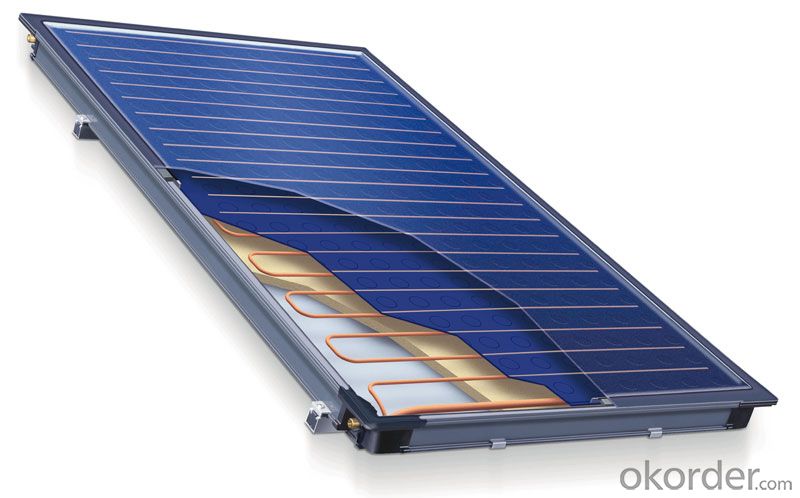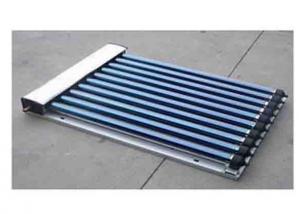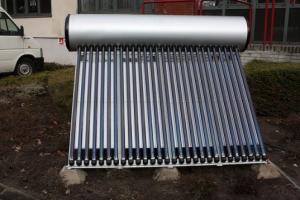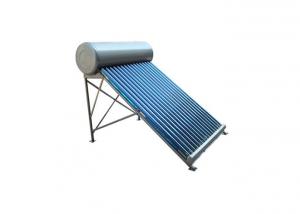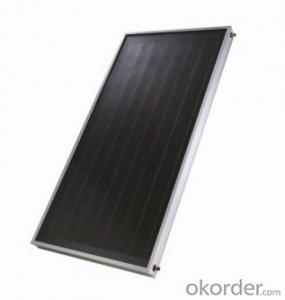PHNIX flat plate solar thermal collectors with Germany absorber
- Loading Port:
- Shanghai
- Payment Terms:
- TT OR LC
- Min Order Qty:
- 500 pc
- Supply Capability:
- 10000 pc/month
OKorder Service Pledge
OKorder Financial Service
You Might Also Like
Specifications
PHNIX flat plate solar thermal collectors with Germany absorber
1.ODM&OEM
2.Absorber:eta plus-Cu from Germany
3.Solar keymark
PHNIX flat plate solar thermal collectors with Germany absorber
It consists of
Flat-plate copper absorber of solar energy : Germany eta plus-Cu
Absorber coating : Highly selective vacuum coating
Heat transfer medium : Polypropylene glycol/water mixture
Insulating layer : Glass wool with great thermostability
Heat transfer medium tube : Copper tube
Outer casing : Aluminum alloy
How does flat plate solar thermal collectors work?
Sunlight passes through the glazing and strikes the absorber plate, which heats up, changing solar energy into heat energy. The heat is transferred to liquid passing through pipes attached to the absorber plate.
Absorber plates are commonly painted with "selective coatings," which absorb and retain heat better than ordinary black paint. Absorber plates are usually made of metal—typically copper or aluminum—because the metal is a good heat conductor. Copper is more expensive, but is a better conductor and less prone to corrosion than aluminum. And our flat plate solar thermal collectors are made of high performance copper absorber.
In locations with average available solar energy, flat plate collectors are sized approximately one-half- to one-square foot per gallon of one-day's hot water use.
Applications
The main use of this technology is in residential buildings where the demand for hot water has a large impact on energy bills. This generally means a situation with a large family, or a situation in which the hot water demand is excessive due to frequent laundry washing. Commercial applications include laundromats, car washes, military laundry facilities and eating establishments. The technology can also be used for space heating if the building is located off-grid or if utility power is subject to frequent outages. Solar water heating systems are most likely to be cost effective for facilities with water heating systems that are expensive to operate, or with operations such as laundries or kitchens that require large quantities of hot water.
Unglazed liquid collectors are commonly used to heat water for swimming pools. Because these collectors need not withstand high temperatures, they can use less expensive materials such as plastic or rubber. They also do not require freeze-proofing because swimming pools are generally used only in warm weather or can be drained easily during cold weather.
While solar collectors are most cost-effective in sunny, temperate areas, they can be cost effective virtually anywhere in the country so should be considered.

- Q: How do solar collectors perform in areas with high levels of airborne debris?
- Solar collectors can still function effectively in areas with high levels of airborne debris, although their efficiency may be slightly diminished. Airborne debris, including dust, pollen, and leaves, can accumulate on the surface of the solar collectors and hinder the amount of sunlight reaching the absorber plate. Consequently, this can result in a decrease in the amount of heat generated by the collectors. Nonetheless, modern solar collectors are designed to be efficient and somewhat self-cleaning. Many collectors are equipped with a smooth surface and are tilted at an angle to prevent debris buildup. Furthermore, certain collectors come with automatic cleaning mechanisms, such as brushes or water sprays, that periodically remove debris. Maintaining and cleaning the solar collectors regularly is crucial in areas with high levels of airborne debris. This may involve manual removal of accumulated debris or using water or air pressure to clean the surface. By ensuring the collectors remain clean, their performance can be maintained at optimal levels. It is important to note that the impact of airborne debris on solar collector performance can vary depending on the type and thickness of the debris, as well as the specific design and technology of the collectors. In some instances, the reduction in efficiency may be minimal, while in others, it could be more significant. To accurately assess the exact impact, it is advisable to consult with a solar energy professional who can provide a more precise evaluation based on the specific conditions and characteristics of the area.
- Q: Can solar collectors be used for heating water?
- Yes, solar collectors can be used for heating water. Solar thermal collectors, also known as solar water heaters, absorb sunlight and convert it into heat energy, which is used to heat water for various purposes such as domestic hot water, swimming pools, or space heating.
- Q: Can solar collectors be used for heating arenas?
- Yes, solar collectors can be used for heating arenas. Solar collectors, such as solar thermal panels, can capture the sun's energy and convert it into heat. This heat can then be used to warm up the air or water that is circulated throughout the arena, providing an eco-friendly and sustainable heating solution.
- Q: Can solar collectors be used for heating churches?
- Yes, solar collectors can be used for heating churches. Solar collectors, such as solar thermal systems or solar panels, can effectively capture and convert sunlight into heat energy, which can then be used for heating purposes. By installing solar collectors on church rooftops or nearby areas, churches can reduce their reliance on traditional heating systems and harness renewable energy to warm their buildings. This can help churches save on energy costs and reduce their environmental impact.
- Q: Are solar collectors suitable for schools and universities?
- Yes, solar collectors are suitable for schools and universities. Solar collectors, such as solar panels, are an environmentally-friendly and sustainable source of energy. Installing solar collectors in educational institutions like schools and universities can have numerous benefits. Firstly, solar collectors can help educational institutions reduce their carbon footprint and contribute to a greener future. By harnessing the power of the sun, schools and universities can generate clean energy, reducing their reliance on fossil fuels and decreasing greenhouse gas emissions. This aligns with the educational mission of these institutions, teaching students about renewable energy and sustainable practices. Secondly, solar collectors can lead to significant cost savings for schools and universities. Educational institutions typically have large energy demands, with numerous buildings and facilities requiring electricity. By installing solar collectors, these institutions can generate their own electricity, reducing their dependence on the grid and lowering their energy bills. Over time, the cost savings from using solar energy can be substantial, allowing schools and universities to allocate more resources to educational programs and initiatives. Moreover, solar collectors can serve as educational tools themselves. By incorporating solar energy systems into the curriculum, students can learn about renewable energy technology, energy efficiency, and the science behind solar power. This hands-on learning experience can enhance students' understanding of sustainable practices and inspire them to pursue careers in renewable energy or related fields. Additionally, solar collectors can act as a visual representation of an educational institution's commitment to sustainability. By showcasing their use of clean energy, schools and universities can inspire their students, staff, and surrounding community to adopt more environmentally-friendly practices. This can create a culture of sustainability within the institution and contribute to a positive image in the community. In conclusion, solar collectors are highly suitable for schools and universities. They provide a sustainable source of energy, reduce carbon emissions, and lead to significant cost savings. Moreover, they serve as educational tools and promote a culture of sustainability. By embracing solar energy, educational institutions can demonstrate their commitment to a greener future while providing valuable learning opportunities for their students.
- Q: Can solar collectors be used for heating military bases?
- Yes, solar collectors can be used for heating military bases. Solar thermal systems can capture the sun's energy and convert it into heat, which can be utilized for space heating, water heating, and other heating needs in military bases. This renewable energy source can help reduce reliance on traditional fossil fuels, enhance energy security, and lower carbon emissions.
- Q: Can solar collectors be used for heating factories?
- Yes, solar collectors can be used for heating factories. By harnessing solar energy and converting it into thermal energy, solar collectors can provide heat for various industrial processes in factories. This renewable and sustainable method of heating can help reduce reliance on traditional fossil fuel-based heating systems, thereby contributing to cost savings and environmental benefits.
- Q: Can solar collectors be used for heating oil refineries?
- Yes, solar collectors can be used for heating oil refineries. Solar thermal technology can provide heat for various industrial processes, including oil refineries. Solar collectors capture sunlight and convert it into thermal energy, which can be used to generate steam or heat fluids. This renewable energy source can help reduce the reliance on fossil fuels and lower operating costs for oil refineries while reducing their carbon footprint.
- Q: Can solar collectors be used for generating electricity on billboards?
- Yes, solar collectors can be used for generating electricity on billboards. Solar collectors, also known as solar panels or photovoltaic (PV) panels, can convert sunlight directly into electrical energy. When installed on billboards, solar collectors can harness the sunlight and convert it into electricity, which can then be used to power the billboard's lighting or other electrical components. This application of solar collectors on billboards offers several benefits. Firstly, it allows billboards to be self-sufficient in terms of energy supply, reducing or even eliminating their dependence on the electrical grid. This can lead to significant cost savings and a more sustainable operation. Additionally, using solar collectors on billboards promotes renewable energy usage and reduces carbon emissions. By harnessing the sun's energy, billboards can contribute to reducing the environmental impact associated with traditional fossil fuel-based electricity generation. Furthermore, solar collectors on billboards can also serve as a visible symbol of the company's commitment to sustainability and renewable energy. It can enhance the brand image and attract environmentally conscious consumers. However, there are a few factors to consider when installing solar collectors on billboards. The size of the solar collectors should be carefully determined to ensure they fit within the available space on the billboard without obstructing the visibility of the advertisement. Additionally, the positioning and orientation of the solar collectors should be optimized to maximize sunlight exposure and electricity generation. Overall, solar collectors can indeed be used for generating electricity on billboards, offering numerous advantages such as cost savings, environmental benefits, and improved brand image.
- Q: Can solar collectors be used in areas with limited internet connectivity?
- Yes, solar collectors can be used in areas with limited internet connectivity. Solar collectors are primarily used to capture and convert sunlight into electricity or heat, and their functionality is not dependent on internet connectivity. However, in such areas, monitoring or remote control of solar collectors may be challenging due to limited access to the internet, making it difficult to track their performance or make adjustments remotely. Nonetheless, solar collectors can still be effectively utilized to generate renewable energy in areas with limited internet connectivity.
Send your message to us
PHNIX flat plate solar thermal collectors with Germany absorber
- Loading Port:
- Shanghai
- Payment Terms:
- TT OR LC
- Min Order Qty:
- 500 pc
- Supply Capability:
- 10000 pc/month
OKorder Service Pledge
OKorder Financial Service
Similar products
Hot products
Hot Searches
Related keywords


